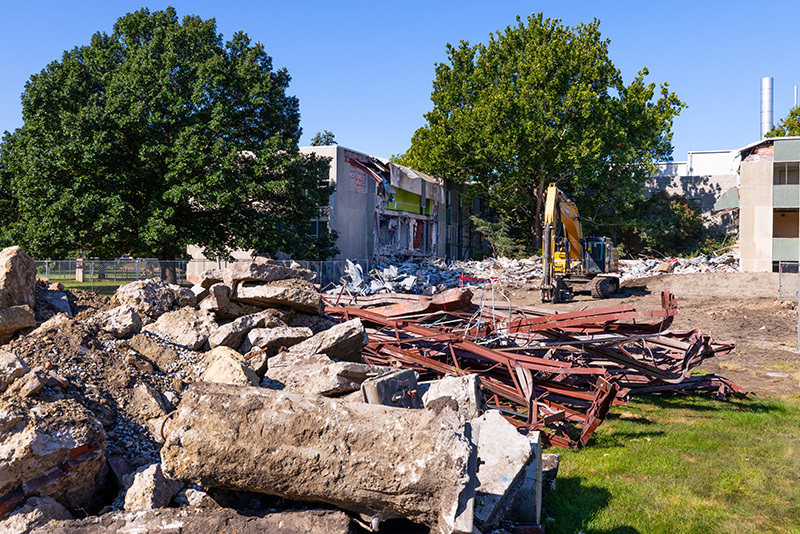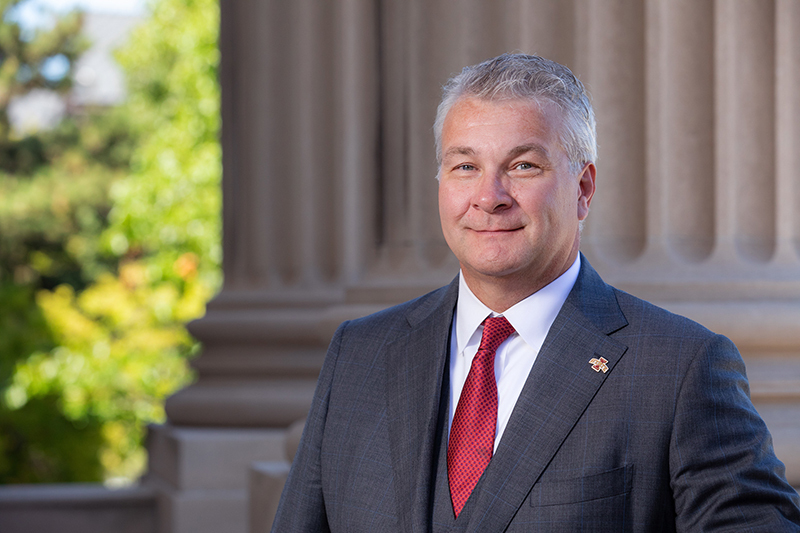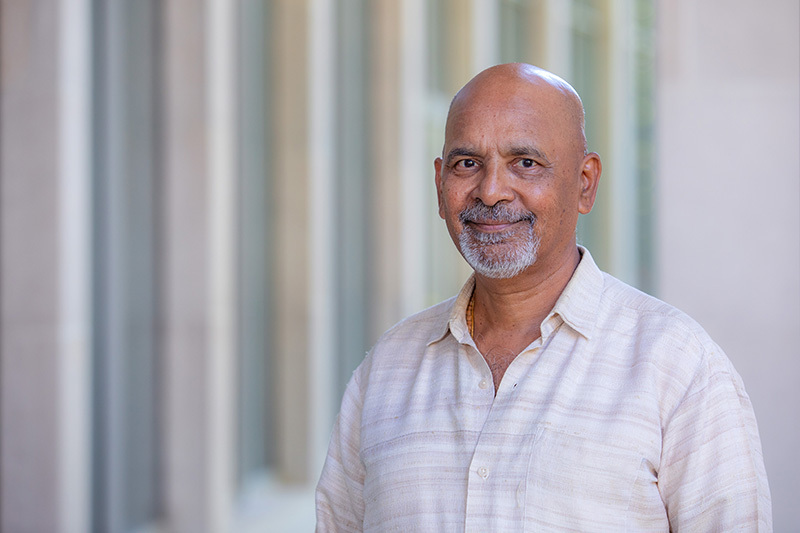Demolition week at LeBaron Hall

Piles of concrete and scrap iron collect near the first demolished section of LeBaron Hall Tuesday. The tree (center) standing in the building's former center courtyard will be removed during demolition. Photos by Christopher Gannon.
Demolition of LeBaron Hall on the north edge of central campus should be nearly completed by the end of the week. It may take up to two weeks to haul away the sorted building debris (pictured above).
Some of the demolition material will be ground and used to cover the fenced-in construction staging area on the east side of LeBaron, eliminating the need to purchase limestone for this purpose, said construction manager Bart Dobson, facilities planning and management. He also said all the interior solid wood doors were sold to an Iowa Amish group that can repurpose much of the wood for tables and other furniture.
Campus history buffs will remember that for about 40 years (1895-1938) the first residence hall for women, Margaret Hall, stood about where LeBaron also did. Dobson said crews came across a section of the Margaret Hall foundation this week.
Stay safe
Members of the campus community are asked to observe directional signs and be alert to large trucks hauling demolition -- and soon, construction -- materials in that part of campus.
Welcome

Senior vice president for operations and finance Sean Reeder. Photo by Christopher Gannon.
Sean Reeder started Sept. 3 in his new role as Iowa State's senior vice president for operations and finance.
The operations and finance division includes nearly 30 units, organized by function into six areas: finance, financial planning and analysis, facilities management, auxiliary enterprises, real estate and capital planning, and operations and strategy.
Reeder arrives in Ames from Kansas City, where he served for more than two years as chief financial officer and vice chancellor for finance and administration at the University of Missouri, Kansas City. He served previously as vice president for business affairs and chief financial officer at Eastern Illinois University, Charleston (2020-22). He spent 11 years at the University of Illinois, Urbana-Champaign, first as assistant director for capital programs (2009-15) and later as assistant vice president of capital programs and utility services, and president of the university-owned energy corporation, Prairieland Energy Inc. (2016-20).
Reeder has extensive experience in capital projects, utilities, real estate development and university technology transfer in higher education. His career also includes roles in private sector real estate development, venture capital and capital projects engineering.
Post-high school, he served for five years in the U.S. Navy aboard a nuclear submarine.
Reeder earned a bachelor's degree in general engineering, a master's in business administration and a Ph.D. in education policy, organization and leadership, all from the University of Illinois.
Reeder's office is in 1350 Beardshear Hall. He can be reached by email at sdreeder@iastate.edu, or by contacting his administrative assistant, Schyler Polaski, 515-294-7662.
Preview the new sign-on dashboard next week
Starting Monday, Sept. 9, all faculty and staff will find a temporary tile in Okta to set up multifactor authentication (MFA) and self-service password reset options ahead of the move to the new Microsoft sign-on dashboard. Completing this setup will provide the best experience when Microsoft officially becomes the Iowa State dashboard on Sept. 16.
Information Technology Services (ITS) is planning a two-step process this month for the previously announced migration from Okta to Microsoft. The location for the dashboard (login.iastate.edu) will not change. Here's the timeline:
- Preview phase. On Monday, Sept. 9, the new Microsoft sign-on dashboard will be available to preview via the temporary tile in Okta. Campus users will receive an email Monday from ITS with more details about the new dashboard, and during the week they're encouraged to sign in to confirm access and get familiar with nuanced differences between the old and new systems.
- Transition phase. During the week of Sept. 16, the new sign-on dashboard will replace the Okta dashboard (the URL will redirect from the Okta to Microsoft dashboard). While users will notice minor visual changes, the more significant changes are background upgrades that will improve the security of digital identities at Iowa State.
Pay attention to multifactor authentication
In early August, ITS transferred campus users' text and voice call verification factors to Microsoft. Not all methods were transferable, including the Okta Verify app. During the preview week, users are encouraged to review their transferred factors and set up more factors before the official transition on Sept. 16.
- Verification methods automatically transferred: SMS text and voice call (if users provided them)
- Verification method no longer available: Okta Verify app
- New verification method available Sept. 9: Microsoft Authenticator app
- Verification method available, but user will need to set up again: Google Authenticator app
- Verification method available, but rollout will be delayed: YubiKey
The Microsoft and Google authenticator apps are free downloads (Apple and Android versions).
Use the new dashboard
On Sept. 16, ITS again will notify campus users via email that the new dashboard is live. For those who confirmed access and MFA factors during preview week, the transition should be seamless. The log-in process will remain largely the same. Users will:
- Go to login.iastate.edu
- Enter their full email address and password
- Complete multifactor authentication
- See a dashboard to access your apps such as Workday, Canvas and others.
The new sign-on dashboard will be preloaded with the apps used most by faculty and staff, but each user can add, remove and customize apps to their liking.
Review your bookmarks
Did you bookmark the Okta site? Once the new dashboard is live, users should review any bookmarks they've made to the sign-on dashboard. The destination of the bookmark should be login.iastate.edu, not iastate.okta.com, which is a bookmark for the Okta dashboard.
Access to Okta dashboards
Individuals' Okta dashboards will be available for a time at okta.iastate.com and through a link on the new Microsoft dashboard. Users can open the two dashboards in separate browser windows to compare them or to customize their Microsoft sign-on dashboard.
"While both dashboards will be available this fall, we encourage everyone to use only the new Microsoft dashboard to log in to apps and university system," said Amy Ward, identity services manager, ITS. "We have taken steps to keep both dashboards operational during the transition, but the best experience will come from using the new dashboard."
Self-help resources
Campus users are invited to visit the project webpage to review information about the sign-on dashboard's transition from Okta to Microsoft, including ITS' summer email messages ("communications archive"). They may email any questions to Ward's project team at identitygovernance@iastate.edu.
If users experience issues logging in, they should contact the IT Solution Center, 294-4000, or email solution@iastate.edu.
Currently, the sign-on dashboard change impacts all faculty, staff and students with these exceptions:
- Role account Net-IDs
- Ames Lab employees
- Campus users who only use a YubiKey for multifactor authentication.
Ward said ITS will help transition these groups later this semester.
Why the change?
The Microsoft sign-on dashboard creates a seamless environment with the Microsoft apps already in use at the university and improves digital security for the campus community by consolidating more functions in one enterprise system.
In 2017, when Iowa State implemented the two-step verification process for logging in to university systems, Okta was the system chosen for the MFA and a secure sign-on dashboard. The evolution of systems and digital identity since then necessitated an update.
Meet Rahul Parsa, Faculty Senate president

Photo by Christopher Gannon.
The Faculty Senate participates in shared governance of Iowa State with university administrators. Faculty Senate president Rahul Parsa is the second consecutive term faculty member elected to the position and third in its history.
Why do you want to lead the Faculty Senate?
I used to be tenure-track faculty when I was at Drake University (25 years) and now I am term faculty here, so I see both sides. I have been through the tenure process, promotion, trying to publish and what it takes to do research. It's not easy. Also, I see how it's not easy as term faculty to teach, be in the classroom and advise students. At the end of the day -- term or tenure -- we are here for the students and we want them to be successful.
What do you want to address during your presidency?
I see three critical issues that the Senate might have to address in artificial intelligence (AI), diversity, equity and inclusion and salaries. AI is here to stay because it is the future and we are already seeing many great applications for it. As AI takes hold, we should be ready to adapt and change the curriculum as needed. We also are working to determine what actions are required to comply with a new law that imposes restrictions on diversity, equity and inclusion offices. Finally, faculty and staff salaries must be competitive. In any university, people come and go, but the reason for their departure should not be their salaries. We want the university to be an inclusive and welcoming place for all.
You've had a significant role in informing faculty about artificial intelligence. What do you see as next steps?
While we have incorporated artificial intelligence in the curriculum with an AI major and minor, we also see some negative impacts. We must remain vigilant. The faculty and university need to create some guardrails because we want the students to benefit from it while guarding against misinformation.
Your thoughts on the senate working with a new provost for the first time in 12 years?
I am excited to see provost Jason Keith join us. When he interviewed for the position, he presented a sheet of Iowa State’s priorities and how his vision fit into it. I loved it and saw he shared our vision and mission. I have since had a chance to talk to him and understand his vision. He recognizes the importance of the Faculty Senate and realizes how important shared governance is, especially at Iowa State. I am looking forward to working with him.
What's something you enjoy about Iowa State and recommend to faculty and staff?
Iowa State is often listed as one of the nation's most beautiful colleges or universities. I want people to walk around, enjoy the beauty and admire the flowers -- the hibiscus plants. Let’s appreciate the landscape and, more importantly, the people who create this landscape. We have a gorgeous campus that we should all be proud of it. Go Cyclones!
A bit of structure for your writing demands
Most of us can sympathize with the pressure of pending deadlines and procrastinated priorities. Writing can be especially daunting for even the most experienced professionals, and writing-based tasks often get pushed to the back burner.
Smile and Write is a free online community available to faculty and staff who need a structured, supportive environment to work on their writing projects -- to light a fire under those back burner projects.
Interested staff and faculty register to receive a Zoom link to their preferred Smile and Write session. Smile and Write members gather at their scheduled time, work on individual projects with their videos on, and then share their progress at the end of the session.
"What I like about Smile and Write is that if there is a task that seems insurmountable to start, that tends to be . . . 'I can't seem to find time to do this' . . . those are the ones that I'll put on my list to do," said Rachel Derscheid, associate professor of veterinary diagnostic and production animal medicine. "I have been so much more productive in terms of actually getting projects to completion."
Derscheid joined Smile and Write in the fall 2020 semester and found it was an effective approach to completing backlogged work.
"I had tried other methods before, early in my career here. I could never get to a point where I really committed the time that I needed. Writing always kind of came last."
Melissa Chamberlain, associate professor of management and entrepreneurship, shared a similar sentiment.
"I had hit a point as an assistant professor where I needed a little more motivation to get things done," she said. "It put a lot of structure in my day, which I had to some extent, but just needed more."
For Chamberlain, the ability to schedule specific appointments helped her establish a "protected time" to focus on her projects. She said the Smile and Write program helped her set aside daily distractions, better organize her time and find a writing community.
"It's kept the momentum going for my research and my writing," she explained. "Even though many of us feel confident in how we organize our time and prioritize work, there's always stuff on our agenda that don't get the time it deserves."
Derscheid noted the program has helped her "stay connected to the manuscripts" she was working on and ties Smile and Write to her professional success at Iowa State.
"I am looking at these projects at least once a month but usually weekly. This may not be helpful for everyone, but for me, this was exactly the kind of accountability I needed," she said. "I honestly don't know that I would have become tenured without it."
She said she tries to commit to two sessions a week and uses this time to work on various projects: developing workshops, grant writing, manuscript edits and other important tasks. She even has organized an informal cadre of colleagues who meet outside their weekly Smile and Write time slot.
Chamberlain also appreciates the camaraderie that forms among colleagues pursuing similar goals.
"I think it's also nice just to see other people. There are a lot of us who do this fairly regularly," she said.
The Smile and Write program runs through Dec. 11 and picks up again in spring semester. In addition to a regular Tuesday session, there are options on other weekdays at varying times. For those who want to find a community centered on productivity, accountability and mutual support, consider registering for a scheduled time to see whether Smile and Write can put a fire under projects left simmering on the back burner.
